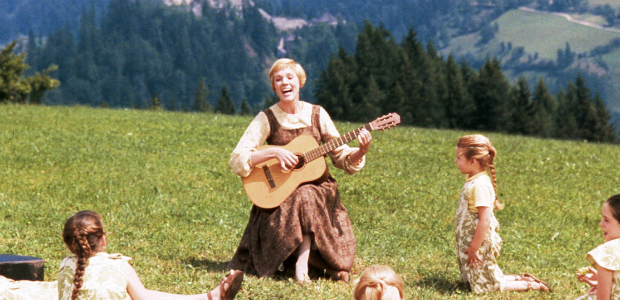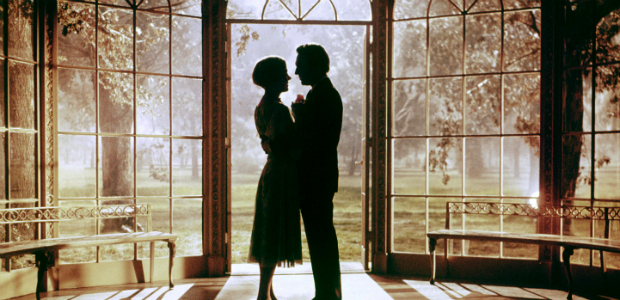
The hills are still alive
Prof. Caryl Flinn on the enduring appeal of The Sound of Music
Spring is finally here in Michigan. I was gathering my thoughts for this column while walking my dog and out of nowhere saw a young woman in the green, guitar in hand. Even without any drapery-clad “urchins” around her, she showed me that The Sound Of Music is always ready to bump into real life.
There’s not a line of the film that I don’t know by heart, a time that I don’t cry when the Captain breaks ranks with his hyper-disciplined masculinity and speak-sings for the first time (actually, Bill Lee did Plummer’s singing, for which he was paid $500 and would receive no official credit). My mom first took me to see it for the first time, and then eventually agreed to pay the exorbitant special price for the soundtrack LP: $6.00. We listened to it together, over and over. We were like most members of the film’s initial audience: children and women, and were also typical for returning to see it again. The Sound Of Music was one of the first films to generate the phenomenon of repeat viewers, and theatre owners and Fox took note. Not only did this guarantee an unusually long run, but soon led to people lodging complaints to their local newspapers and theatres to change the damn movie).

The Sound Of Music communities are forged of nostalgia, cheer and impossible, singable fantasy, features that characterise the film itself.
The Sound Of Music has withstood nearly every test of time and marketing campaigns: Salzburg had a special postal stamp when the film opened, and since its release, has became a tourist destination. Fox flew Charmain Carr (Liesl), to promote the musical across the globe; the studio also took the unusual step of re-recording the songs in foreign languages. Its exposure from variety TV shows (in the US, the children appeared on Ed Sullivan), and of course the LP. Arguably its audiences—and impact –skyrocked, from annual television broadcasts. Its broadcast premiere in the UK was Christmas day where over 26m viewers tuned in, rendering it a special ritual (in addition to acknowledging its nearly religious iconic status among fans). It has undergone endless DVD pressings, interviews (Plummer politely suffering; Andrews graciously repeating the same anecdotes), coffee table books such as a superb “making of” and a “photo album” compiled by actors who’d depicted the children, along with a slim “Film Classics” volume by this fan for the BFI. For that, the charge was to demonstrate “what makes The Sound Of Music a film classic.” Easy! The music. The playful numbers, the heartrending Edelweiss. Even its underscore stuns: during the ball, we hear portions of “How can love survive?” one of the songs dropped from the stage version, as the Baroness returns from her “visit” to Maria upstairs.

People of my generation are showing it to their kids and grandkids; parodies exist right and left, Will and Grace had a “Von Trapped” episode; In the UK, there was a television movie of the same name in 2004. The Sound Of Music still airs on TV—often around holidays. Despite official markers of its endurability—The Sound Of Music hit its half-century anniversary in 2015, with predictable publicity frenzy. In any given year one can find, though, the sing-along Sound Of Music in local theatres. They are cheeky, endearing affairs that transform audiences into active participants, hissing at the poor baroness, outfitted in lederhosen and dirndls, usually with a lot of nuns in drag. At one, during the shot of goose-legging Nazis, a young boy behind me loudly asked, “Are those the boy scouts, Nana?”
The Sound Of Music is everywhere, and the affectionate, campy sing-alongs—not to mention the ones that happen in private homes– dramatise the ritualistic, communitarian function it still serves. The most successful sing-alongs, as Desiree Garcia notes, are folk musicals, which stress community above all else (compare Grease to Beauty and the Beast in that regard). I’d argue that the first singalong occurred in The Sound Of Music itself, when the Captain implores his “fellow Austrians” to join him in the faux-folksong “Edelweiss.”
The Sound Of Music is the rare movie that has forged communities among members of all stripes and across divides. It’s been shared intergenerationally and among various sub-communities women, families, Catholics, musical fans, all those men in drag… if rituals depend on familiarity, repetition and certain form of consensual value, one could argue that those of The Sound Of Music communities are forged of nostalgia, cheer and impossible, singable fantasy, features that one finds in the film itself.
The Sound of Music will screen at the BFI in 70mm from 18 May before expanding to wider release throughout the UK and internationally.







COMMENTS